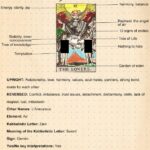The Two of Swords is a compelling card within the Tarot deck, symbolizing the intricate dance of choices, duality, and the need for a profound shift in perspective. The imagery often depicts a figure seated, blindfolded, with two swords crossed before them. This striking tableau hints at a stalemate, a period of indecision, and a challenge to confront the heart of one’s dilemmas. Yet, it is in this very confrontation that profound insights and transformative narratives begin to unfold.
At its core, the Two of Swords embodies the essence of conflict—not only between external circumstances but more significantly, within the self. This card invites an exploration into the dichotomy of the mind: logic versus emotion, clarity versus confusion. When encountered in a reading, it often serves as a prompt to delve deeply into areas of one’s life that may seem murky or unresolved. It beckons individuals to strip away the layers of illusions and to confront underlying truths, which can ultimately lead to a significant recalibration of one’s perspectives.
To fully grasp the intricacies of the Two of Swords, one must appreciate the symbolism embedded in its imagery. The blindfold over the figure’s eyes starkly represents the state of denial or confusion, forcing the individual to rely on intuition rather than sight. The swords—the tools of intellect—are crossed, signifying the clash of conflicting thoughts and emotions. The posture of the figure, seated yet defensive, reflects a state of stagnation that many may find relatable at various points in their lives.
This card frequently signifies a moment of pause—a necessary respite before making crucial decisions. The universe often provides these moments to encourage reflection and deliberation. It prompts individuals to engage in introspection, steering them toward a deeper understanding of their desires and the motivations behind their choices. This is the pivotal moment to interrogate personal beliefs and challenge the status quo of thoughts that may limit growth or exploration.
Moreover, the Two of Swords signifies an impending paradigm shift. It encourages individuals to envision a future beyond the turmoil of their present circumstances. When decisions loom large, emotions tend to cloud judgment, creating barriers to clarity. The presence of this card nudges one towards disentangling themselves from the webs of confusion woven by emotional turmoil. A necessary shift in perception can unveil new paths previously obscured by the dense foliage of anxiety and fear.
For many, this card serves as a catalyst for change. It calls for the courage to embrace vulnerability and to confront the inner conflicts head-on. It nudges individuals to seek balance within, harmonizing the cerebral with the emotional. The act of removing the blindfold can lead to enlightenment, making way for clarity and understanding. When one acknowledges the unresolved conflicts, not as insurmountable obstacles but as opportunities for growth, the possibilities become limitless.
Additionally, the Two of Swords emphasizes the dual nature of choices. Each decision creates a fork in the road, leading to divergent paths that can shape destinies. It symbolizes the power of choice and the responsibility that accompanies it. Choices are laden with potential, while indecision can become a self-imposed prison. The crossing swords serve as a reminder that stagnation breeds dissatisfaction and that embracing the uncertainty of choice is essential for advancement.
In a practical context, the Two of Swords encourages individuals to communicate openly about their feelings and to seek counsel from trusted sources. Often, conversations serve as catalysts that spark enlightenment, providing insights that may not have been apparent during solitary contemplation. The act of sharing thoughts and emotions can alleviate burdens and help clarify one’s internal landscape. This communal exploration can dissipate feelings of isolation, fostering an atmosphere where mutual understanding flourishes.
Importantly, the Two of Swords does not advocate for rash decisions. Instead, it implores individuals to exercise patience. The stillness encouraged by this card is not a sign of weakness but a strategic pause, allowing for the assimilation of thoughts and emotions. By assessing all angles and considering the potential consequences of each choice, an individual invariably empowers themselves to make informed decisions that resonate with their authentic self.
In relationships, this card can appear during times of ambiguity. It may indicate communication breakdowns or unresolved conflicts that require addressing before progress can be made. It serves as an awareness tool, prompting individuals to articulate their feelings honestly, thereby paving the way for healing and understanding. A shift in perspective in these situations can illuminate paths towards reconciliation or, conversely, serve as a recognition of the need for personal boundaries.
In conclusion, the Two of Swords is far more than a mere representation of indecision; it is a profound invitation to explore the depths of one’s psyche. By embracing the themes of duality and conflict, individuals can navigate through personal dilemmas toward enlightenment. This card encourages a sacred exploration of self, paving the way for transformative insights and decisive action. To encounter the Two of Swords is to stand at the precipice of possibility, poised for a metamorphosis that promises to redefine one’s understanding of choice and consequence. It whispers the potential for new horizons if only one dares to remove the blindfold and confront the swords of reality head-on.






Leave a Comment